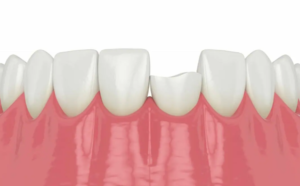5 Oral Symptoms That You May Need a Root Canal Procedure

A root canal is a dental procedure that removes decayed or infected tissue inside a tooth’s root. This treatment stops the pain and restores the health of your tooth. The only way to know for sure that you need an emergency root canal treatment is to visit your dentist and get a professional diagnosis.
Root canal procedures are a common and effective solution for saving a damaged or infected tooth. In this procedure, the damaged or infected portion of the tooth is removed, and the tooth is then filled and sealed. While there are many reasons a person may need a root canal, there are five specific oral symptoms and signs you need a root canal.
1. Teeth Pain
If you experience tooth pain that doesn’t go away, it could signify a tooth infection. It’s common to feel a little pain in your teeth when you eat, drink, or use them, but when it’s persistent and accompanied by other symptoms, it’s time to see your dentist for a root canal procedure.
Getting a root canal is a dental procedure that removes the inside of your tooth’s pulp, a layer of tissue containing nerves. The dentist uses a dental drill tool to get into the area and remove damaged tissue and bacteria.
You’ll also receive a local anesthetic to make you more comfortable during the procedure. Then, the dentist will clean out the infected pulp and fill the tooth with a special material to prevent the regrowth of bacteria.
Once the tooth is free of the infected tissue, it’s important to keep up with your oral hygiene routine. You should brush twice a day, floss between your teeth, and use fluoride toothpaste to help keep your gums healthy.
It’s also important to regularly visit your dentist for check-ups and cleanings to keep your teeth healthy. Often, tooth pain is caused by other oral health problems, like cavities, an infected impacted tooth, a gum disease, or a damaged filling.
2. Swelling
When you notice swelling in your mouth, it can signify several issues. If it’s a new problem or one that isn’t improving, it’s a good idea to see your dentist as soon as possible.
Swelling that is due to infection can be painful, but it usually subsides quickly after antibiotic treatment. However, swelling lasting longer than a few days indicates the disease has spread.
A root canal procedure removes infected tissue from inside the tooth (known as the pulp). It can save your natural tooth from a serious infection or damage.
It can also make your teeth more resistant to cavities and fractures. It can also reduce the risk of jawbone damage if you have an infected tooth.
During the procedure, your dentist or endodontist will remove any infected nerve tissue and clean and seal the inside of your tooth’s pulp chamber. This is called a root canal, which will help eliminate the pain associated with tooth infection.
Root canals are often successful, and a well-treated tooth will be functional for a long time. They’re also considered a relatively low-risk procedure, with success rates between 90 to 95 percent.
The success of a root canal process depends on the size and shape of your tooth’s roots and the anatomy of your tooth. Teeth with complex branching, horizontal roots, and multiple root canals are more likely to fail.
3. Darkening of Teeth
The color of your teeth reflects the health and condition of the tooth enamel and dentin underneath. Healthy teeth can range from light yellow to light gray, and the color of your teeth depends on factors like diet, aging, and genetics.
Several different things, including extrinsic and intrinsic damage, can cause teeth that turn black or dark brown. Extrinsic damage is usually the result of staining, tartar buildup, or other damage to the outer dental enamel.
Intrinsic damage is more serious and can be caused by tooth decay or injury to the tooth. If the cause of the discoloration is intrinsic, your dentist may be able to repair it through emergency root canal treatment to remove the damaged area.
Some kinds of antibiotics can also stain teeth. The tetracycline antibiotics your dentist prescribes during pregnancy can stain the tooth’s inner tissue, which is called the pulp.
In addition, trauma to the tooth can darken it, especially if you’ve been knocked in the mouth. This can affect enamel formation and disrupt blood flow to the tooth.
You should see your dentist immediately for testing and consultation if you have a gray or black tooth. This is because gray and black teeth can be signs you need a root canal for an infection or a dead tooth, which needs to be extracted. Infections are a major oral health risk and can lead to other issues in your body, such as heart disease or brain dysfunction.
4. Pimple on the Gums
Several things, including a tooth infection, can cause a pimple on the gums. This condition is not only painful, but it can also cause tooth loss if left untreated.
Getting a proper diagnosis from a dentist as soon as possible is important. This will ensure that the condition is treated and doesn’t spread to other body parts.
The pimple on your gums could result from bacterial buildup due to poor dental hygiene or recent tooth extraction. It’s essential to keep your teeth and gums clean and healthy, as this will help prevent the occurrence of boils or infections.
Antibiotics are required when a pimple on the gums results from an infection. Other treatments can include using mouthwash that contains essential oils like peppermint oil, clove oil, cinnamon oil, or tea tree oil.
Dentures can also contribute to a pimple on the gums because they don’t fit properly. However, this is a false claim, as dentures don’t cause boils on the gums.
Tooth decay left untreated will eventually progress to the tooth’s nerve and cause a gum boil. This is because the tooth decay will eat through the root of the tooth and form an abscess that will then burrow into the bone.
A dentist will drain the pus from the abscess and treat the infection. This usually involves cleaning, medications, and possibly a small amount of drilling. Depending on the severity of the condition, the dentist may also need to perform a root canal procedure or remove the tooth.
5. Loose Teeth
Whether you’re experiencing loose teeth due to injury or gum disease, it’s important to get to the root of the issue. Treating the underlying cause will help prevent further complications or tooth loss, which can be devastating.
A tooth that’s been fractured or broken may need a root canal process to fix the damage. This procedure removes damaged or infected tissue, including the nerve, to keep it from spreading.
Teeth that are loose or shifting may be caused by a dental issue, such as gum disease, which you can treat with deep cleanings and antibiotics. Gum disease can also erode your bone and soft tissue, making it more difficult to keep your teeth in place.
If you have gum disease, your dentist can use a deep cleaning procedure called scaling and root planing to remove bacteria beneath the gum line and improve your oral health. This type of procedure can also prevent further damage to your teeth and gums by keeping them free from plaque buildup.
Loose teeth may be signs you need a root canal for an underlying problem, so it’s important to schedule an appointment for an assessment with a dentist as soon as possible. Depending on the cause of your loose teeth, your dentist can determine the best treatment option for you.
How long does a root canal take?
A root canal is a dental procedure that is performed to remove infected or damaged pulp from the inside of a tooth. The length of the procedure can vary, but it typically takes between 60 to 90 minutes for a single rooted tooth and up to 2 hours for multiple rooted teeth or a particularly complicated case. The duration of the procedure depends on several factors, including the size and shape of the tooth, the location and extent of the damage, and the experience of the dentist performing the procedure.
During a root canal, the dentist will numb the area around the tooth and make an opening in the top of the tooth to access the pulp. The infected or damaged pulp is then removed, the inside of the tooth is cleaned and disinfected, and the canal is filled with a rubber-like material called gutta-percha. The tooth is typically sealed with a filling or crowned to protect it and restore its function.
In summary, the length of a root canal can range from 60 minutes to 2 hours, depending on the case’s complexity.
Conclusion
If you notice any of these oral symptoms, it may be time to call your dentist and schedule an emergency root canal treatment. This treatment is necessary when your tooth pulp becomes infected or damaged due to trauma, cracks in your teeth, repeated dental procedures, and deep decay that reaches the root canal. Do you need oral surgery in Queen Creek now? Then, visit your dentist as soon as possible and don’t wait for the problem to worsen.
You should expect some tenderness and swelling after your root canal, but this should subside within a few days. Your dentist can ease this discomfort with over-the-counter pain medications, cold compresses, and gentle oral hygiene.
If you experience any of these symptoms, it’s important to schedule a dental appointment as soon as possible. Root canal procedures are typically performed in a single appointment and can save a damaged or infected tooth from extraction. A root canal-treated tooth can last a lifetime with proper care and regular dental check-ups.
In conclusion, paying attention to oral symptoms and seeking prompt dental treatment is key to preserving oral health. If you experience any of the symptoms listed above, make an appointment with your dentist to determine if a root canal process is necessary.
AUTHOR BIO
Erik Clark is the Lead Marketing Manager at Flatirons Periodontics & Implant Dentistry, a leading center for periodontics and dentistry in Boulder, CO. They are known throughout the region for creating healthy and beautiful smiles that last forever.






